The global tuboplasty market is projected to grow from USD 50.2 million in 2025 to approximately USD 68.8 million by 2035, recording an absolute increase of USD 18.6 million over the forecast period. This translates into a total growth of 37.1%, with the market forecast to expand at a compound annual growth rate (CAGR) of 3.2% between 2025 and 2035.
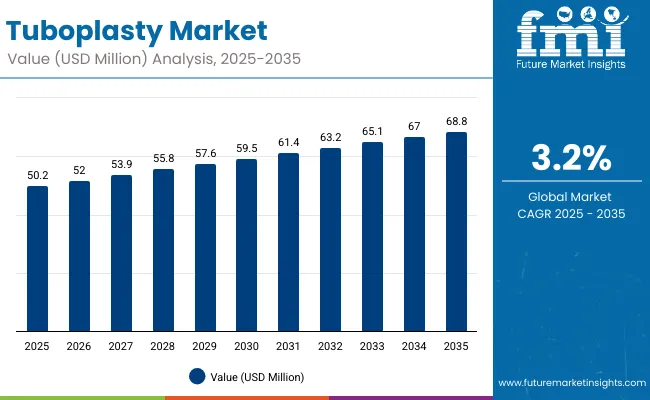
Tuboplasty Market Key Takeaways
| Metric | Value |
|---|---|
| Estimated Value in (2025E) | USD 50.2 million |
| Forecast Value in (2035F) | USD 68.8 million |
| Forecast CAGR (2025 to 2035) | 3.20% |
The overall market size is expected to grow by approximately 1.4X during the same period, supported by increasing demand for minimally invasive surgical procedures, growing awareness of female reproductive health, and rising adoption of advanced surgical technologies across the global hospital and fertility center sectors.
Between 2025 and 2030, the tuboplasty market is projected to expand from USD 50.2 million to USD 61.4 million, resulting in a value increase of USD 11.2 million, which represents 60.2% of the total forecast growth for the decade. This phase of development will be shaped by increasing adoption of microsurgical techniques, rising demand for fertility restoration procedures, and growing utilization in specialized gynecology departments. Medical device manufacturers and surgical equipment specialists are expanding their product portfolios to address the growing preference for precision surgical instruments in tuboplasty procedures.
From 2030 to 2035, the market is forecast to grow from USD 61.4 million to USD 68.8 million, adding another USD 7.4 million, which constitutes 39.8% of the overall ten-year expansion. This period is expected to be characterized by the advancement of minimally invasive surgical technologies, the integration of robotic-assisted surgical platforms for premium tuboplasty procedures, and the development of specialized instruments for complex reproductive surgical applications. The growing emphasis on patient outcomes optimization and surgical precision will drive demand for advanced tuboplasty instruments with enhanced visualization capabilities and improved surgical effectiveness.
Between 2020 and 2024, the tuboplasty market experienced steady growth, driven by increasing awareness of reproductive health solutions and growing recognition of tuboplasty procedures' effectiveness in treating tubal infertility across hospital and fertility center applications. The market developed as healthcare providers recognized the potential for microsurgical tuboplasty to restore fertility while meeting modern healthcare requirements for minimally invasive treatment options. Technological advancement in surgical instrumentation and microsurgical techniques began emphasizing the critical importance of maintaining surgical precision while extending patient outcomes and improving reproductive success rates.
The tuboplasty market represents a specialized reproductive health opportunity at the intersection of microsurgical technology, fertility restoration, and advanced gynecological procedures, with the market projected to expand from USD 50.2 million in 2025 to USD 68.8 million by 2035 at a moderate 3.2% CAGR a 1.4X growth driven by increasing fertility awareness, demand for minimally invasive procedures, and the integration of advanced surgical technologies into reproductive healthcare.
This convergence opportunity leverages the growing emphasis on fertility preservation, advances in microsurgical techniques, and the increasing availability of specialized reproductive surgical services to create solutions that offer precise fallopian tube repair and restoration. Surgical instruments lead with 28.2% market share due to their critical role in microsurgical procedures and precision requirement, while hospitals with gynecology & reproductive surgery departments dominate end user demand as specialized centers increasingly invest in advanced reproductive surgical capabilities. Geographic growth is strongest in China (4.8% CAGR) and India (4.4% CAGR), where expanding healthcare infrastructure and growing reproductive health awareness create favorable market conditions.
Pathway A - Surgical Instruments Technology Leadership
The dominant product category offers superior precision, microsurgical compatibility, and specialized functionality essential for tuboplasty procedures. Companies developing advanced surgical instruments with enhanced visualization integration, improved ergonomic design, and specialized microsurgical capabilities will capture the leading technology segment. Expected revenue pool: USD 18-25 million.
Pathway B - Hospital Gynecology Department Integration
The largest end user segment benefits from growing institutional investment in reproductive surgery capabilities and comprehensive fertility treatment programs. Providers developing specialized tuboplasty solutions with seamless integration into existing gynecological surgical suites, comprehensive training programs, and clinical outcome optimization will dominate this primary market. Opportunity: USD 25-30 million.
Pathway C - Advanced Microsurgical Technology and Precision Enhancement
Next-generation tuboplasty requires sophisticated microsurgical instruments capable of precise tissue manipulation, enhanced visualization, and minimal tissue trauma. Companies investing in advanced optics, precision instrumentation, and microsurgical platform integration will create competitive differentiation and premium positioning. Revenue uplift: USD 8-12 million.
Pathway D - Geographic Expansion in High-Growth Asian Markets
China and India's expanding reproductive healthcare infrastructure and growing fertility treatment demand create substantial opportunities. Local partnerships, specialized training programs, and culturally adapted surgical approaches enable market penetration in these high-growth regions. Pool: USD 10-15 million.
Pathway E - Minimally Invasive Procedure Development
Modern patients and healthcare providers prioritize reduced invasiveness and faster recovery times. Developing instruments and techniques that enable laparoscopic tuboplasty, reduce surgical trauma, and improve post-operative outcomes addresses growing demand for patient-centered surgical approaches. Expected upside: USD 6-10 million.
Pathway F - Fertility Center and IVF Integration
Specialized fertility clinics represent growing opportunities for comprehensive reproductive surgical services and integrated fertility treatment approaches. Systems offering seamless integration with fertility treatment protocols, outcome tracking, and patient management create enhanced value propositions. USD 8-12 million.
Pathway G - Endoscopic and Robotic Platform Integration
Advanced surgical platforms require specialized tuboplasty instruments compatible with endoscopic and robotic surgical systems. Developing specialized instruments for robotic-assisted tuboplasty and endoscopic approaches expands treatment options and appeals to technology-advanced medical centers. Pool: USD 5-8 million.
Pathway H - Premium Surgical Training and Education Programs
High-end market segments demand comprehensive training, certification programs, and ongoing educational support for complex microsurgical procedures. Companies developing premium training platforms with simulation capabilities, certification programs, and ongoing clinical support will capture premium pricing opportunities. Expected revenue: USD 4-7 million.
Market expansion is being supported by the increasing global demand for fertility restoration procedures and the corresponding shift toward minimally invasive surgical technologies that can provide superior patient outcomes while meeting healthcare requirements for precise and effective reproductive surgical intervention. Modern healthcare providers are increasingly focused on incorporating advanced tuboplasty techniques to enhance fertility treatment success rates while satisfying demands for comprehensive reproductive healthcare services and specialized gynecological surgical capabilities. Tuboplasty procedures' proven ability to deliver effective tubal repair, fertility restoration, and patient satisfaction makes them essential treatments for reproductive health programs and specialized gynecology departments.
The growing emphasis on personalized reproductive healthcare and fertility preservation is driving demand for high-quality tuboplasty procedures that can support distinctive patient outcomes and comprehensive fertility treatment positioning across hospital, fertility clinic, and specialized reproductive surgery categories. Healthcare provider preference for procedures that combine surgical excellence with advanced microsurgical capabilities is creating opportunities for innovative tuboplasty implementations in both traditional and emerging reproductive healthcare applications. The rising influence of fertility awareness programs and reproductive health initiatives is also contributing to increased adoption of specialized tuboplasty procedures that can provide authentic fertility restoration characteristics.
The market is segmented by product type, procedure type, application, end user, and region. By product type, the market is divided into surgical instruments, endoscopic systems, catheters & balloon dilators, robotic platforms, and others. Based on procedure type, the market is categorized into microsurgical tuboplasty, laparoscopic tuboplasty, hysteroscopictuboplasty, and others. By application, the market includes tubal reversal, tubal blockage, adhesion removal, fimbrioplasty & salpingostomy, and others. Based on end user, the market covers hospitals with gynecology & reproductive surgery departments, fertility clinics & IVF centers, ambulatory surgical centers, and others. Regionally, the market is divided into North America, Europe, East Asia, South Asia & Pacific, Latin America, and the Middle East & Africa.
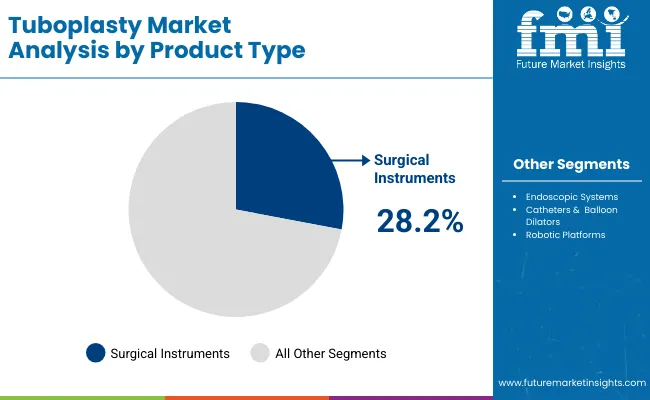
The surgical instruments segment is projected to account for 28.2% of the tuboplasty market in 2025, reaffirming its position as the leading product type category. Medical device manufacturers and surgical equipment producers increasingly utilize specialized surgical instruments for their superior precision capabilities, microsurgical compatibility, and essential functionality in tuboplasty procedures across diverse reproductive surgery applications. Surgical instruments' standardized design elements and proven effectiveness directly address the clinical requirements for precise tissue manipulation and optimal surgical outcomes in reproductive surgical operations.
This product segment forms the foundation of modern tuboplasty applications, as it represents the technology with the greatest surgical precision potential and established compatibility across multiple microsurgical systems. Manufacturer investments in surgical instrument optimization and specialized design continue to strengthen adoption among medical equipment producers. With healthcare providers prioritizing surgical precision and patient outcomes, surgical instruments align with both clinical effectiveness objectives and safety assurance requirements, making them the central component of comprehensive tuboplasty surgical strategies.
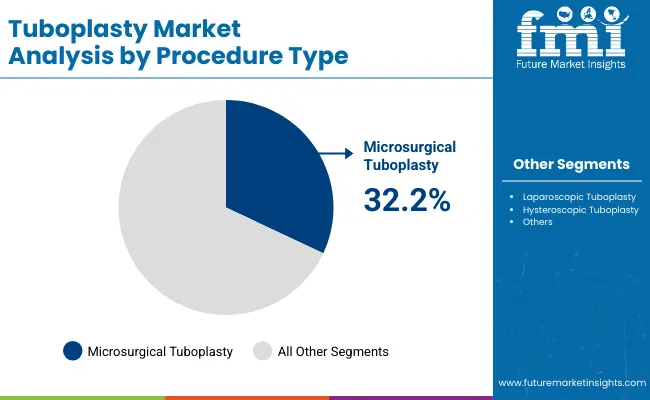
Microsurgical tuboplasty procedures are projected to represent 32.2% of the tuboplasty market in 2025, underscoring their critical role as the primary procedure type for precise reproductive surgical intervention and fertility restoration applications. Healthcare providers and reproductive surgeons prefer microsurgical approaches for their exceptional precision capabilities, enhanced visualization features, and ability to maintain optimal tissue handling while supporting advanced reproductive surgical requirements during complex tuboplasty procedures. Positioned as essential techniques for high-performance reproductive surgery, microsurgical tuboplasty offers both technological advancement and clinical effectiveness advantages.
The segment is supported by continuous advancement in microsurgical technology and the growing availability of specialized training programs that enable enhanced surgical precision and fertility outcome optimization at the procedural level. Additionally, reproductive surgeons are investing in advanced microsurgical techniques to support clinical excellence and improved patient outcomes. As microsurgical technology continues to advance and healthcare providers seek superior precision solutions, microsurgical tuboplasty will continue to dominate the procedure landscape while supporting technology advancement and patient outcome optimization strategies.
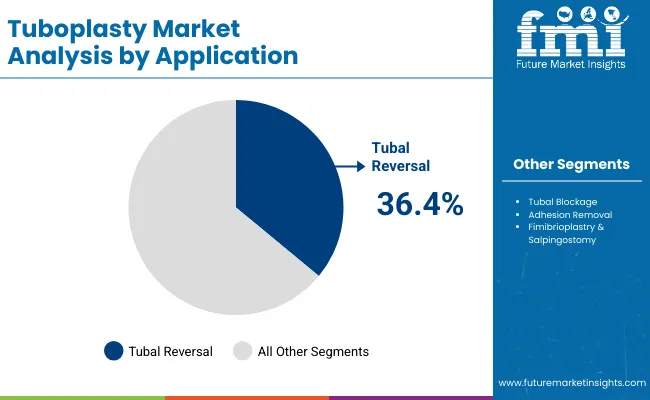
Tubal reversal applications are projected to represent 36.4% of the tuboplasty market in 2025, underscoring their critical role as the primary application for fertility restoration surgical intervention and reproductive health solutions. Healthcare providers and patients prefer tubal reversal procedures for their proven effectiveness in restoring natural fertility, comprehensive approach to reproductive restoration, and ability to provide long-term fertility solutions while supporting natural conception requirements. Positioned as essential procedures for fertility restoration, tubal reversal offers both clinical effectiveness and patient satisfaction advantages.
The segment is supported by growing awareness of fertility preservation options and increasing demand for natural fertility restoration solutions that enable successful conception without ongoing fertility treatments. Additionally, healthcare providers are recognizing the cost-effectiveness and patient preference advantages of tubal reversal compared to alternative fertility treatments. As fertility awareness continues to expand and patients seek natural conception solutions, tubal reversal applications will continue to dominate the application landscape while supporting reproductive health advancement and patient outcome optimization strategies.
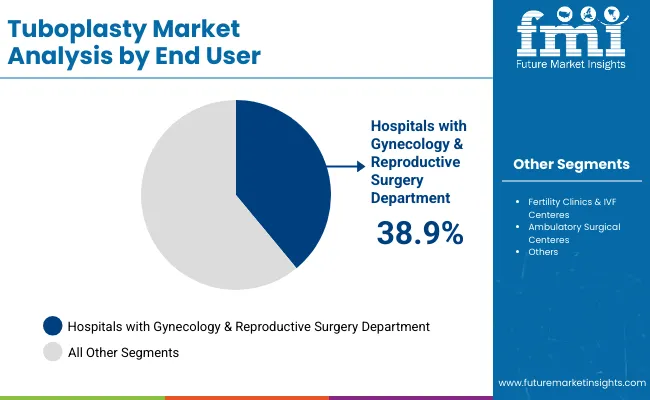
Hospitals with gynecology & reproductive surgery departments are projected to represent 38.9% of the tuboplasty market in 2025, underscoring their critical role as the primary end user for specialized reproductive surgical services and comprehensive gynecological care applications. Healthcare administrators and reproductive surgery departments prefer hospital-based tuboplasty services for their comprehensive surgical capabilities, specialized equipment availability, and ability to provide integrated reproductive healthcare while supporting complex surgical requirements during advanced reproductive procedures. Positioned as essential facilities for high-performance reproductive surgery, hospital departments offer both technological resources and clinical expertise advantages.
The segment is supported by continuous investment in reproductive surgical capabilities and the growing establishment of specialized reproductive surgery programs that enable comprehensive patient care and advanced surgical outcomes at the institutional level. Additionally, hospitals are expanding their reproductive surgery services to support market differentiation and comprehensive women's health positioning. As reproductive healthcare continues to advance and institutions seek specialized service offerings, hospital gynecology & reproductive surgery departments will continue to dominate the end user landscape while supporting clinical excellence and comprehensive reproductive care strategies.
The tuboplasty market is advancing steadily due to increasing reproductive health awareness and growing demand for fertility restoration solutions that emphasize superior patient outcomes across hospital and fertility clinic applications. However, the market faces challenges, including high procedure costs compared to alternative fertility treatments, limited availability of specialized microsurgical expertise, and competition from IVF and other assisted reproductive technologies. Innovation in microsurgical techniques and reproductive surgery training continues to influence market development and expansion patterns.
Expansion of Advanced Microsurgical Technology Applications
The growing adoption of tuboplasty in comprehensive reproductive surgery programs and specialized fertility restoration applications is enabling medical device manufacturers to develop products that provide distinctive surgical capabilities while commanding premium positioning and enhanced clinical outcome characteristics. Advanced applications provide superior precision while allowing more sophisticated reproductive surgical development across various gynecological categories and specialty segments. Manufacturers are increasingly recognizing the competitive advantages of microsurgical technology positioning for premium product development and reproductive surgery market penetration.
Integration of Fertility Outcome Optimization Programs
Modern tuboplasty providers are incorporating advanced surgical planning systems, outcome tracking technologies, and patient management protocols to enhance surgical success rates, improve fertility restoration outcomes, and meet healthcare demands for evidence-based reproductive surgical solutions. These programs improve procedure effectiveness while enabling new applications, including personalized surgical planning and integrated fertility treatment systems. Advanced outcome integration also allows providers to support premium market positioning and clinical excellence leadership beyond traditional reproductive surgery products.
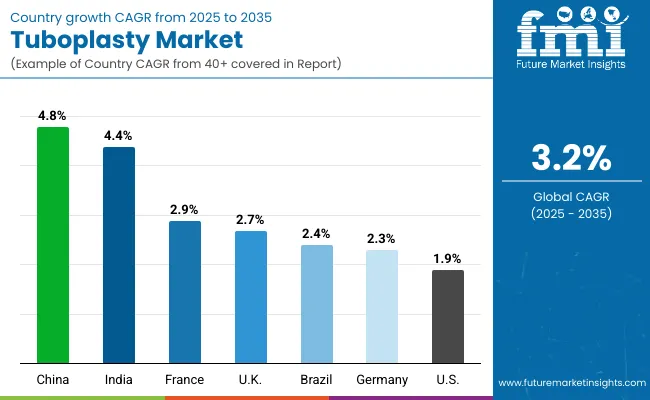
| Country | CAGR (2025 to 2035) |
|---|---|
| China | 4.80% |
| India | 4.40% |
| France | 2.90% |
| UK | 2.70% |
| Brazil | 2.40% |
| Germany | 2.30% |
| USA | 1.90% |
The tuboplasty market is experiencing steady growth globally, with China leading at a 4.8% CAGR through 2035, driven by the expanding healthcare infrastructure, growing fertility awareness campaigns, and increasing adoption of specialized reproductive surgery services. India follows at 4.4%, supported by rising middle-class healthcare spending, expanding fertility treatment access, and growing acceptance of surgical fertility solutions. France shows growth at 2.9%, emphasizing advanced reproductive medicine and comprehensive fertility care development. The UK records 2.7%, focusing on NHS fertility services and private reproductive health expansion. Brazil demonstrates 2.4% growth, prioritizing reproductive health access and fertility treatment infrastructure development. Germany exhibits 2.3% growth, supported by advanced medical technology and specialized fertility centers. Europe shows 2.2% growth, emphasizing regional healthcare coordination and fertility treatment standards. The USA demonstrates 1.9% growth, focusing on advanced reproductive technology and specialized surgical expertise while maintaining market leadership in fertility innovation.
The report covers an in-depth analysis of 40+ countries; eight top-performing countries are highlighted below.
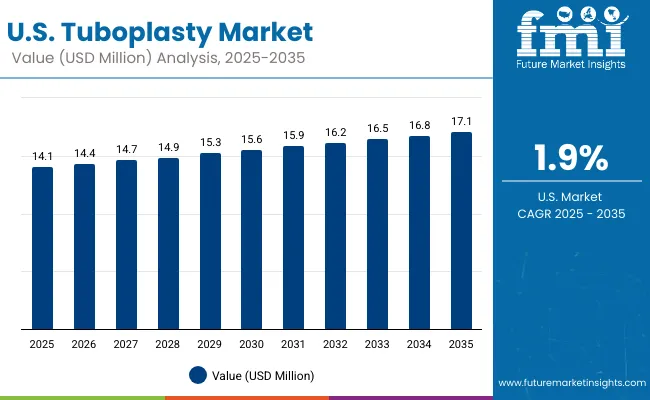
Revenue from tuboplasty procedures in the United States is projected to grow at a CAGR of 1.9% through 2035, supported by stable demand for fertility restoration services and strong adoption of advanced surgical technologies across established healthcare systems. The country’s mature fertility treatment ecosystem, coupled with rising awareness of surgical options for infertility, is driving consistent though moderate expansion. Leading medical device manufacturers and fertility specialists continue to invest in innovation, offering high-quality tuboplasty solutions within a well-regulated clinical environment.
Revenue from tuboplasty procedures in China is projected to exhibit strong growth with a CAGR of 4.8% through 2035, driven by the rapidly expanding healthcare infrastructure and government initiatives supporting reproductive health services across major urban centers. The country's growing fertility awareness and increasing acceptance of surgical fertility treatments are creating substantial demand for tuboplasty procedures in both public and private healthcare settings. Major medical device manufacturers and surgical specialists are establishing comprehensive service capabilities to serve both domestic consumption and regional markets.
Revenue from tuboplasty procedures in India is expanding at a CAGR of 4.4%, supported by rising middle-class healthcare spending, growing fertility awareness, and expanding access to specialized reproductive surgery services. The country's developing fertility treatment infrastructure and increasing acceptance of surgical solutions are driving demand for tuboplasty procedures across both urban and emerging market applications. International medical technology companies and domestic healthcare providers are establishing comprehensive service networks to address growing market demand for fertility restoration solutions.
Revenue from tuboplasty procedures in France is projected to grow at a CAGR of 2.9% through 2035, driven by the country's advanced reproductive medicine sector, comprehensive fertility care systems, and leadership in minimally invasive surgical techniques. France's sophisticated healthcare culture and strong support for reproductive health services are creating steady demand for both standard and advanced tuboplasty procedure varieties. Leading medical centers and fertility specialists are establishing comprehensive treatment strategies to serve both European markets and growing international demand.
Revenue from tuboplasty procedures in the United Kingdom is projected to grow at a CAGR of 2.7% through 2035, supported by the country's comprehensive National Health Service fertility programs, expanding private reproductive health sector, and established expertise in fertility surgery requiring specialized tuboplasty solutions. British patients and healthcare providers consistently seek innovative fertility treatments that enhance natural conception opportunities for both NHS and private healthcare applications. The country's position as a European healthcare leader continues to drive innovation in reproductive surgery applications and treatment standards.
Revenue from tuboplasty procedures in Brazil is projected to grow at a CAGR of 2.4% through 2035, supported by the country's expanding reproductive health infrastructure, growing fertility treatment access, and increasing adoption of specialized surgical procedures requiring tuboplasty solutions. Brazilian healthcare providers and patients prioritize comprehensive fertility care and natural conception alternatives, making tuboplasty procedures essential treatments for both public and private healthcare applications. The country's comprehensive healthcare development and patient care patterns support continued market expansion.
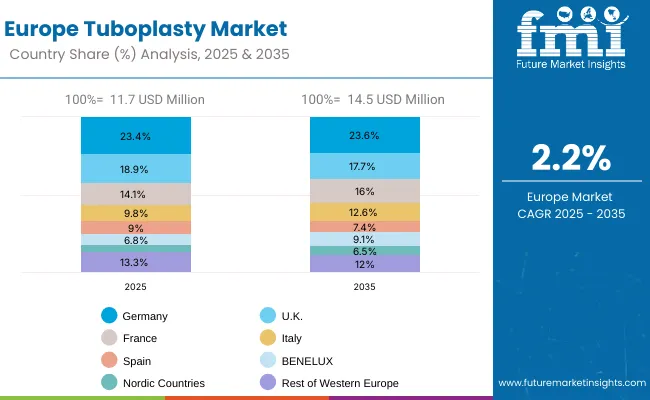
Revenue from tuboplasty procedures in Germany is projected to grow at a CAGR of 2.3% through 2035, supported by the country's advanced medical technology sector, specialized fertility centers, and established expertise in precision surgical procedures. German healthcare providers' focus on innovation, clinical excellence, and comprehensive patient care creates steady demand for tuboplasty procedures. The country's attention to technology integration and clinical outcomes drives consistent adoption across both university medical centers and specialized fertility clinic applications.
The Europe tuboplasty market is projected to grow from USD 11.7 million in 2025 to USD 14.5 million by 2035, recording a CAGR of 2.2% over the forecast period. Germany leads with a 23.4% share in 2025, increasing slightly to 23.6% by 2035, supported by advanced healthcare infrastructure and strong surgical device adoption. The United Kingdom follows with 18.9% in 2025, softening to 17.7% by 2035, driven by steady clinical demand but moderated by healthcare cost controls. France accounts for 14.1% in 2025, rising to 16% by 2035, reflecting consistent growth from advanced fertility treatment centers and supportive medical policies.
Italy holds 9.8% in 2025, expanding to 12.6% by 2035, supported by increasing adoption of minimally invasive procedures. Spain contributes 9% in 2025, moderating to 7.4% by 2035, facing slower adoption rates. The Nordic countries grow from 6.8% in 2025 to 9.1% in 2035, supported by high per-capita healthcare spending. BENELUX holds 6.5% in 2035, slightly down from 6.8% in 2025, reflecting stable demand. The Rest of Western Europe moderates from 13.3% in 2025 to 12% in 2035, reflecting varied growth patterns across smaller healthcare markets.
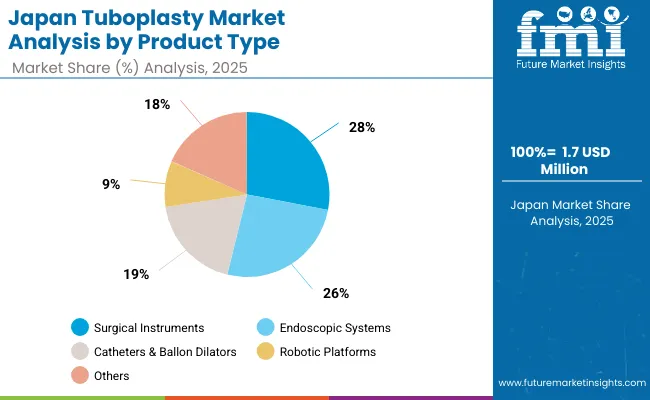
The Japan tuboplasty market is valued at USD 1.7 million in 2025, with surgical instruments holding the lead at 28% share, supported by demand for precision tools in advanced surgical procedures. Endoscopic systems follow closely with 26%, driven by minimally invasive technology adoption and clinical efficiency improvements. Catheters & balloon dilators account for 19%, supported by steady use in routine procedures but facing competitive pressure from advanced robotic solutions. Robotic platforms command 9%, showing potential for expansion through precision-driven automation in specialized clinical centers. The remaining 18% share is attributed to other product categories, reflecting niche adoption patterns and emerging technology integration.
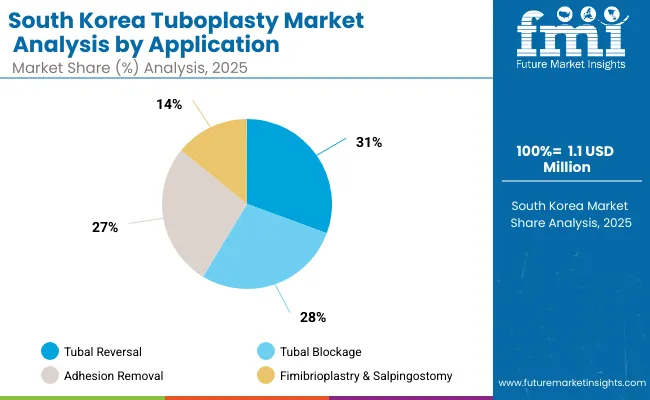
The South Korea tuboplasty market is valued at USD 1.1 million in 2025, led by tubal reversal procedures at 31% share, supported by rising clinical demand and favorable surgical outcomes. Tubal blockage applications hold 28%, driven by therapeutic needs and the adoption of minimally invasive techniques. Adhesion removal accounts for 27%, reflecting consistent demand from infertility treatment centers and advanced surgical practices. Fimbrioplasty & salpingostomy procedures represent 14% share, supported by niche applications but limited by lower overall clinical volume. The balanced distribution highlights South Korea’s diversified demand across multiple procedure types in reproductive surgery.
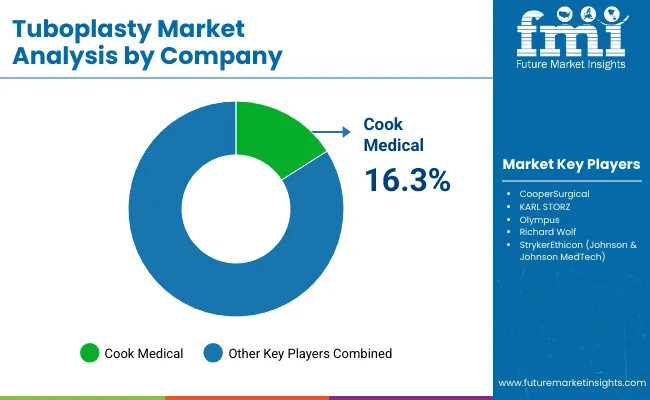
The tuboplasty market is characterized by competition among established medical device companies, specialized surgical equipment manufacturers, and integrated reproductive surgery solution providers. Companies are investing in advanced microsurgical technologies, specialized instrument development systems, application-specific product innovation, and comprehensive clinical training capabilities to deliver consistent, high-performance, and effective tuboplasty solutions. Innovation in surgical precision enhancement, patient outcome optimization, and customized reproductive surgery compatibility is central to strengthening market position and clinical satisfaction.
CooperSurgical leads the market with a strong focus on women's healthcare innovation and comprehensive reproductive surgery solutions, offering advanced tuboplasty instruments with emphasis on clinical effectiveness and surgical precision excellence. KARL STORZ provides specialized endoscopic and microsurgical capabilities with a focus on premium surgical technology and global distribution networks. Olympus delivers integrated surgical systems with a focus on advanced visualization and operational efficiency. Richard Wolf specializes in minimally invasive surgical solutions with an emphasis on reproductive surgery applications. Stryker/Ethicon (Johnson & Johnson MedTech) focuses on comprehensive surgical platforms with advanced technology integration and clinical support excellence.
Key Players in the Tuboplasty Market
| Items | Values |
|---|---|
| Quantitative Units (2025) | USD 50.2 Million |
| Product Type | Surgical Instruments, Endoscopic Systems, Catheters & Balloon Dilators, Robotic Platforms, Others |
| Procedure Type | Microsurgical Tuboplasty , Laparoscopic Tuboplasty , Hysteroscopic Tuboplasty , Others |
| Application | Tubal Reversal, Tubal Blockage, Adhesion Removal, Fimbrioplasty & Salpingostomy , Others |
| End User | Hospitals with Gynecology & Reproductive Surgery Department, Fertility Clinics & IVF Centers , Ambulatory Surgical Centers , Others |
| Regions Covered | North America, Europe, East Asia, South Asia & Pacific, Latin America, Middle East & Africa |
| Countries Covered | United States, Canada, United Kingdom, Germany, France, China, Japan, South Korea, India, Brazil, Australia and 40+ countries |
| Key Companies Profiled | CooperSurgical , KARL STORZ, Olympus, Richard Wolf, and Stryker/Ethicon (Johnson & Johnson MedTech ) |
| Additional Attributes | Dollar sales by product type, procedure type, application, and end user; regional demand trends, competitive landscape, technological advancements in microsurgical instruments, reproductive surgery integration initiatives, clinical outcome optimization programs, and fertility restoration enhancement strategies |
The tuboplasty market is estimated to be valued at USD 50.2 million in 2025.
The tuboplasty market is projected to reach USD 68.8 million by 2035.
The tuboplasty market is expected to grow at a 3.2% CAGR between 2025 and 2035.
The key product types in the tuboplasty market are surgical instruments, endoscopic systems, catheters & balloon dilators, robotic platforms, and others.
In terms of end users, hospitals with gynecology & reproductive surgery departments are anticipated to command 38.9% share of the tuboplasty market in 2025.






Our Research Products

The "Full Research Suite" delivers actionable market intel, deep dives on markets or technologies, so clients act faster, cut risk, and unlock growth.

The Leaderboard benchmarks and ranks top vendors, classifying them as Established Leaders, Leading Challengers, or Disruptors & Challengers.

Locates where complements amplify value and substitutes erode it, forecasting net impact by horizon

We deliver granular, decision-grade intel: market sizing, 5-year forecasts, pricing, adoption, usage, revenue, and operational KPIs—plus competitor tracking, regulation, and value chains—across 60 countries broadly.

Spot the shifts before they hit your P&L. We track inflection points, adoption curves, pricing moves, and ecosystem plays to show where demand is heading, why it is changing, and what to do next across high-growth markets and disruptive tech

Real-time reads of user behavior. We track shifting priorities, perceptions of today’s and next-gen services, and provider experience, then pace how fast tech moves from trial to adoption, blending buyer, consumer, and channel inputs with social signals (#WhySwitch, #UX).

Partner with our analyst team to build a custom report designed around your business priorities. From analysing market trends to assessing competitors or crafting bespoke datasets, we tailor insights to your needs.
Supplier Intelligence
Discovery & Profiling
Capacity & Footprint
Performance & Risk
Compliance & Governance
Commercial Readiness
Who Supplies Whom
Scorecards & Shortlists
Playbooks & Docs
Category Intelligence
Definition & Scope
Demand & Use Cases
Cost Drivers
Market Structure
Supply Chain Map
Trade & Policy
Operating Norms
Deliverables
Buyer Intelligence
Account Basics
Spend & Scope
Procurement Model
Vendor Requirements
Terms & Policies
Entry Strategy
Pain Points & Triggers
Outputs
Pricing Analysis
Benchmarks
Trends
Should-Cost
Indexation
Landed Cost
Commercial Terms
Deliverables
Brand Analysis
Positioning & Value Prop
Share & Presence
Customer Evidence
Go-to-Market
Digital & Reputation
Compliance & Trust
KPIs & Gaps
Outputs
Full Research Suite comprises of:
Market outlook & trends analysis
Interviews & case studies
Strategic recommendations
Vendor profiles & capabilities analysis
5-year forecasts
8 regions and 60+ country-level data splits
Market segment data splits
12 months of continuous data updates
DELIVERED AS:
PDF EXCEL ONLINE

Thank you!
You will receive an email from our Business Development Manager. Please be sure to check your SPAM/JUNK folder too.
Chat With
MaRIA